英语Unit4《Globalwarming》教案(3)(新人教版选修6)
新人教选修六 Unit 4 Global warming单元教学设计
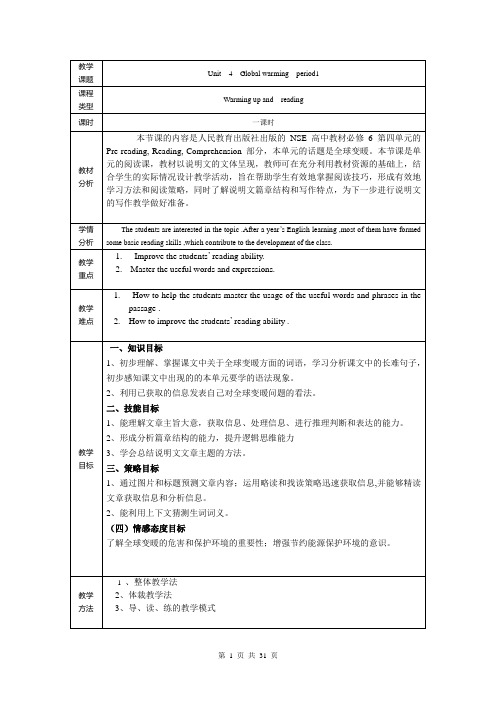
教学课题Unit 4 Global warming period1 课程类型Warming up and reading课时一课时教材分析本节课的内容是人民教育出版社出版的NSE高中教材必修6第四单元的Pre-reading, Reading, Comprehension 部分,本单元的话题是全球变暖。
本节课是单元的阅读课,教材以说明文的文体呈现,教师可在充分利用教材资源的基础上,结合学生的实际情况设计教学活动,旨在帮助学生有效地掌握阅读技巧,形成有效地学习方法和阅读策略,同时了解说明文篇章结构和写作特点,为下一步进行说明文的写作教学做好准备。
学情分析The students are interested in the topic .After a year’s English learning ,most of them have formed some basic reading skills ,which contribute to the development of the class.教学重点1.Improve the students’ reading ability.2.Master the useful words and expressions.教学难点1.How to help the students master the usage of the useful words and phrases in thepassage .2.How to improve the students’ reading ability .教学目标一、知识目标1、初步理解、掌握课文中关于全球变暖方面的词语,学习分析课文中的长难句子,初步感知课文中出现的的本单元要学的语法现象。
2、利用已获取的信息发表自己对全球变暖问题的看法。
二、技能目标1、能理解文章主旨大意,获取信息、处理信息、进行推理判断和表达的能力。
高中英语 Unit 4 Global warming Reading 教案 新人教版选修6
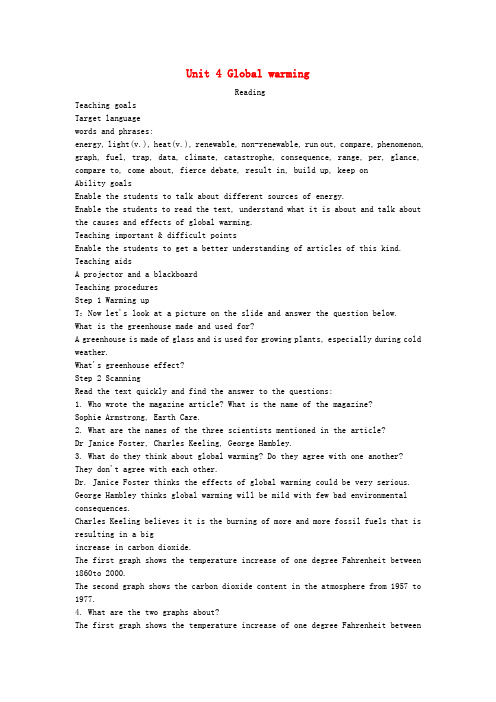
Unit 4 Global warmingReadingTeaching goalsTarget languagewords and phrases:energy, light(v.), heat(v.), renewable, non-renewable, run out, compare, phenomenon, graph, fuel, trap, data, climate, catastrophe, consequence, range, per, glance, compare to, come about, fierce debate, result in, build up, keep onAbility goalsEnable the students to talk about different sources of energy.Enable the students to read the text, understand what it is about and talk about the causes and effects of global warming.Teaching important & difficult pointsEnable the students to get a better understanding of articles of this kind. Teaching aidsA projector and a blackboardTeaching proceduresStep 1 Warming upT:Now let's look at a picture on the slide and answer the question below.What is the greenhouse made and used for?A greenhouse is made of glass and is used for growing plants, especially during cold weather.What's greenhouse effect?Step 2 ScanningRead the text quickly and find the answer to the questions:1. Who wrote the magazine article? What is the name of the magazine?Sophie Armstrong, Earth Care.2. What are the names of the three scientists mentioned in the article?Dr Janice Foster, Charles Keeling, George Hambley.3. What do they think about global warming? Do they agree with one another? They don't agree with each other.Dr. Janice Foster thinks the effects of global warming could be very serious. George Hambley thinks global warming will be mild with few bad environmental consequences.Charles Keeling believes it is the burning of more and more fossil fuels that is resulting in a bigincrease in carbon dioxide.The first graph shows the temperature increase of one degree Fahrenheit between 1860to 2000.The second graph shows the carbon dioxide content in the atmosphere from 1957 to 1977.4. What are the two graphs about?The first graph shows the temperature increase of one degree Fahrenheit between1860to 2000. The second graph shows the carbon dioxide content in the atmosphere from 1957 to 1977.5. What is the main topic of the article?Global warming/ the warming of the earth.Step 3 SkimmingRead the passage carefully and judge whether the statements are true or false.1. The temperature last century didn't increase much.2. Everyone believes that global warming is caused by the activities of humans.3. Janice Foster believes that global warming is caused b the burning fossil fuels.4. Natural gas is a greenhouse gas.5. Carbon dioxide is a byproduct of burning fossil fuels.6. People accept Charles Keeling's data because he took accurate measurements.7. Flooding could be one of the effects of future global warming.8. George Hambley believes scientists are just guessing about the effects of global warming.9. George Hambley is worried about the effects of carbon dioxide on plant growth.10. It is clear what the effects of global warming will be.Keys: True: 3, 5, 6, 7, and 8 False: 1, 2, 4, 9, 10Step 4 Detailed readingRead the text carefully and try to find out how many parts we can divide the text into and find out the main idea of each part.Part (Para_ to Para_ )Main ideaPart 1 (Para _1_)introduce a debate over the issue of global warmingPart 2 (Para _2__ to _4__)illustrate how global warming comes aboutPart 3 (Para _5__ to 10___)list two different attitudes among scientists towards global warmingPart 4 (Para _11__ to ___)It's up to readers to think and decide whether people should do something about global warming or not.Step 5 DebateGet into groups of six. Decide which three in your group are going to agree with the statement and which three are going to disagree with the statement.Group A: We shall do something about global warming.Group B: We shall do nothing about global warming.Group A discuss why they agree with the statement; Group B discuss why they disagree. Group A and B get together. Tell each other the reasons why agree or disagree with the statement.Step 6 Homework1. Read the passage again and review the new words and expressions.2. Prepare the debate in groups.3. Surf the Internet for more information about global warming中国书法艺术说课教案今天我要说课的题目是中国书法艺术,下面我将从教材分析、教学方法、教学过程、课堂评价四个方面对这堂课进行设计。
选修六unit-4-global-warming教师教案.docx
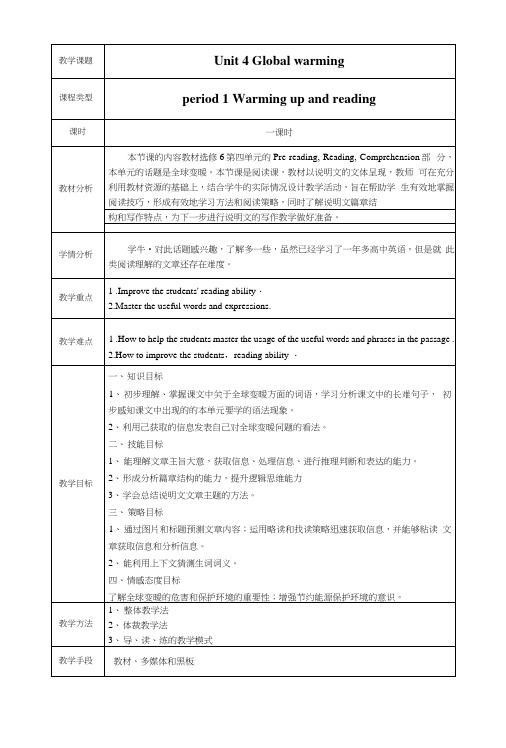
教学课题Unit 4 Global warming课程类型period 1 Warming up and reading 课时一课时教材分析本节课的内容教材选修6第四单元的Pre-reading, Reading, Comprehension部分,本单元的话题是全球变暖。
本节课是阅读课,教材以说明文的文体呈现,教师可在充分利用教材资源的基础上,结合学牛的实际情况设计教学活动,旨在帮助学生有效地掌握阅读技巧,形成有效地学习方法和阅读策略,同时了解说明文篇章结构和写作特点,为下一步进行说明文的写作教学做好准备。
学情分析学牛•对此话题感兴趣,了解多一些,虽然已经学习了一年多高中英语,但是就此类阅读理解的文章还存在难度。
教学重点1 .Improve the students' reading ability・2.Master the useful words and expressions.教学难点 1 .How to help the students master the usage of the useful words and phrases in the passage .2.How to improve the students,reading ability ・教学目标一、知识目标1、初步理解、掌握课文中关于全球变暖方面的词语,学习分析课文中的长难句子,初步感知课文中岀现的的本单元要学的语法现象。
2、利用己获取的信息发表自己对全球变暖问题的看法。
二、技能目标1、能理解文章主旨大意,获取信息、处理信息、进行推理判断和表达的能力。
2、形成分析篇章结构的能力,提升逻辑思维能力3、学会总结说明文文章主题的方法。
三、策略目标1、通过图片和标题预测文章内容;运用略读和找读策略迅速获取信息,并能够粘读文章获取信息和分析信息。
2、能利用上下文猜测生词词义。
四、情感态度目标了解全球变暧的危害和保护环境的重要性;增强节约能源保护环境的意识。
Unit4《GlobalWarming》教案6(人教版选修6)
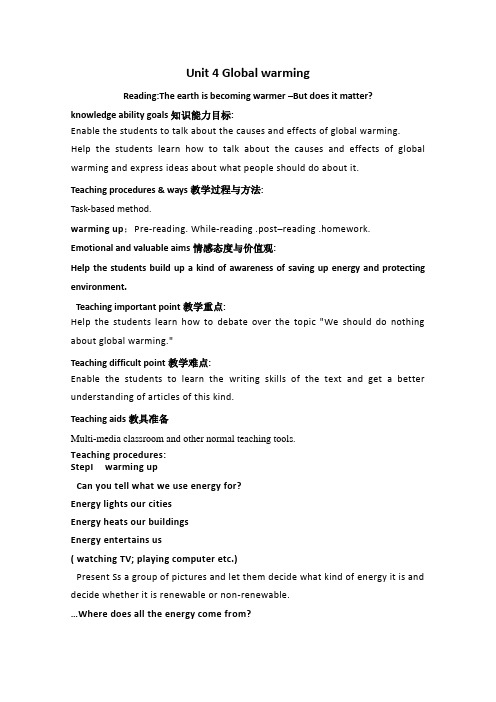
Unit 4 Global warmingReading:The earth is becoming warmer –But does it matter? knowledge ability goals知识能力目标:Enable the students to talk about the causes and effects of global warming. Help the students learn how to talk about the causes and effects of global warming and express ideas about what people should do about it.Teaching procedures & ways教学过程与方法:Task-based method.warming up;Pre-reading. While-reading .post–reading .homework. Emotional and valuable aims情感态度与价值观:Help the students build up a kind of awareness of saving up energy and protecting environment.Teaching important point教学重点:Help the students learn how to debate over the topic "We should do nothing about global warming."Teaching difficult point教学难点:Enable the students to learn the writing skills of the text and get a better understanding of articles of this kind.Teaching aids教具准备Multi-media classroom and other normal teaching tools.Teaching procedures:StepI warming upCan you tell what we use energy for?Energy lights our citiesEnergy heats our buildingsEnergy entertains us( watching TV; playing computer etc.)Present Ss a group of pictures and let them decide what kind of energy it is and decide whether it is renewable or non-renewable.…Where does all the energy come fr om?Picture1 Wind millsPicture2 : a coal power stationPicture3:an oil refinery Picture4:a nuclear power plant Picture5:Solar panels Picture6: a hydro damStep II Pre-reading ;1. Show a picture of greenhouse on the screen, and ask1. What is it in the picture?It ’s a greenhouse made of glass.2. What is it used for?It ’s used for growing plants, especially during cold weather.3. How does it work?The air inside is warm because the glass traps the heat from the sun and keeps it from escaping. This makes the greenhouse heat up and so the plants can grow throughout the cold period.4. What is greenhouse gases?The gases surrounding the earth,including carbon dioxide, methane and water vapor.5. What do you think greenhouse gases do?They trap heat from the sun and therefore warm the earth.Step III While- readingTask 1: skimmingGlance quickly at the magazine article and answer the questions.1. Who wrote the magazine article? What is the name of the magazine?Sophie Armstrong wrote the magazine article. The name of the magazine is Earth Care.2. What are the names of the three scientists mentioned in the article?They are Dr. Janice Foster, Charles Keeling and George Hambley.3…. What is the main topic of the article?Global warming/ the warming of the earth.Task 2:listen andScan the textRead it quickly and try to get the general idea and divide the whole passage into several parts and summarize the main idea.False: 1, 2, 4, 9, 10Correct sentences:1. The temperature last century increased much.2. Not everyone believes that global warming is caused by human activities. 4. Natural gas is not a greenhouse gas but a fossil fuel.9. George Hambley thinks that more carbon dioxide is a positive thing and it will make plants grow faster.10. It is unknown what the effects of global warming will be.Task 3: Group activity .Should we do nothing about global warming?StepⅣPost-reading:1.write a summary.Do not include your own opinion, but be sure to use our own words (about 30words.)(不能添加自己的见解,但是要用自己的语言概括.大约30个词左右)The reading passage is a discussion and puts forward different points of view about the effect of increased carbon dioxide in the atmosphere the causes of theearth’s increased temperature and the possible effects .Ste pIIV.HomeworkRead the passage again and review the new words and expressions.。
2020_2021学年高中英语Unit4GlobalwarmingSectionⅢGrammar教师用书教案新人教版选修6

Unit 4 Global warmingit 的用法(Ⅱ)语境自主领悟先观察原句后自主感悟1.There is no doubt that the earth isbecoming warmer and that it is humanactivity that has caused this globalwarming rather than a random but naturalphenomenon.2.It was a scientist called CharlesKeeling who made accurate measurements ofthe amount of carbon dioxide in theatmosphere from 1957 to 1997.3.They also agree that it is the burningof more and more fossil fuels that hasresulted in this increase in carbondioxide.1.例1中的it is...that...为强调句型,在这个句型中,it没有意义,只是引出被强调的成分。
此处强调的是同位语从句的主语human activity。
2.例2中的it was...who...为强调句型,此处强调的是主句的主语a scientist。
被强调的成分是表示人的词,故也可用who。
3.例3中的it is...that...为强调句型,此处强调的是宾语从句的主语the burning ofmore and more fossil fuels。
一、强调句型的基本结构强调句型的基本结构为:it is/was+被强调部分+that/who+其他成分1.此结构中it 没有意义,只是引出被强调部分。
2.此强调句型只能强调主语、宾语、状语,不能强调谓语。
3.被强调的成分是表示人的词时用who/that,而被强调成分是其他时(事物、时间、地点等)只能用that。
Unit4GlobalWarming教案
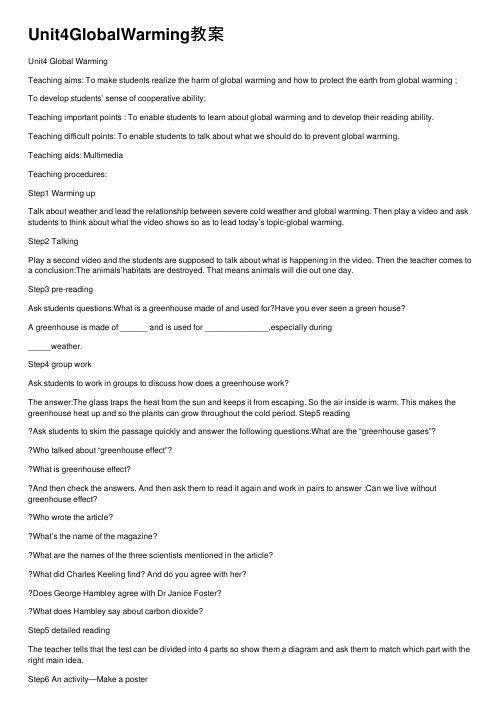
Unit4GlobalWarming教案Unit4 Global WarmingTeaching aims: To make students realize the harm of global warming and how to protect the earth from global warming ;To develop students’ sense of cooperative ability;Teaching important points : To enable students to learn about global warming and to develop their reading ability. Teaching difficult points: To enable students to talk about what we should do to prevent global warming.Teaching aids: MultimediaTeaching procedures:Step1 Warming upTalk about weather and lead the relationship between severe cold weather and global warming. Then play a video and ask students to think about what the video shows so as to lead today’s topic-global warming.Step2 TalkingPlay a second video and the students are supposed to talk about what is happening in the video. Then the teacher comes to a conclusion:The animals’habitats are destroyed. That means animals will die out one day.Step3 pre-readingAsk students questions:What is a greenhouse made of and used for?Have you ever seen a green house?A greenhouse is made of ______ and is used for ______________,especially during_____weather.Step4 group workAsk students to work in groups to discuss how does a greenhouse work?The answer:The glass traps the heat from the sun and keeps it from escaping. So the air inside is warm. This makes the greenhouse heat up and so the plants can grow throughout the cold period. Step5 readingAsk students to skim the passage quickly and answer the following questions:What are the “greenhouse gases”Who talked about “greenhouse effect”What is greenhouse effectAnd then check the answers. And then ask them to read it again and work in pairs to answer :Can we live without greenhouse effect?Who wrote the articleWhat’s the name of the magazineWhat are the names of the three scientists mentioned in the articleWhat did Charles Keeling find And do you agree with herDoes George Hambley agree with Dr Janice FosterWhat does Hambley say about carbon dioxideStep5 detailed readingThe teacher tells that the test can be divided into 4 parts so show them a diagram and ask them to match which part with the right main idea.Step6 An activity—Make a posterSaving energy means reducing carbon dioxide, which is our duty.What should we do to slow down global warming?Make a poster for our school that tells students various ways they can reduce the amount of carbon dioxide in the air.Step7 HomeworkComposition:以“how to slow down global warming?”为题写⼀篇发⾔稿。
最新人教版选修六unit4《global warming》教案3.doc

英语:Unit4《Global warming》教案(3)(新人教版选修6)Pre-reading, Reading, ComprehendingTeaching Goals:1.To read about global warming.2.To get some idea about the effect of global warming.3.To develop some basic reading skills.Teaching Procedures:Step 1. Warming UpPurpose: To arouse Ss interest in learning about global warming.1. Team workAnswer the questions below:(1) Have you ever seen a greenhouse?(2) How does a greenhouse work?(3) What do you think greenhouse gases do?2. Group workLook at the picture, and ask Ss some questions.T: What is this building made of?S1: It’s made of plastic.T: What’s its purpose?S2: Plants can grow in it when it’s cold outside.T: How does it work?S3: The glass traps the heat from the sun, making the air warm so that plants grow better.Step 2. Pre-readingPurpose: To get Ss to learn about greenhouse gases.1. Group workNow look at the word “GREENHOUSE GASES”. What does it mean?Greenhouse gases (GHG) are gaseous components of the Array atmosphere that contribute to the greenhouse effect .Themajor natural greenhouse gases are water vapor, whichcauses about 36-70% of the greenhouse effect on Earth(not including clouds): carbon dioxide, which causes between 9-26%; and ozone,which causes between 3-7%(note that it is not really possible to assert thatsuch-and-such a gas causes a certain percentage of the GHE, because theinfluences of the various gases are not additive .The higher ends of the rangesquoted are for the gas alone ;the lower end ,for the gas counting overlaps). Naturally occurring greenhouse gases include water vapor, carbon dioxide, methane, nitrousoxide, and ozone. Certain human activities, however, add to the levels of mostof these naturally occurring gases.Very powerful greenhouse gases that are not naturally occurring includehydrofluorocarbons(HFCs), perfluorocarbons (PFCs), and sulfur hexafluoride (SF6), which aregenerated in avariety of industrial processes.Each greenhouse gas differs in its ability to absorb heat in the atmosphere.HFCs and PFCsare the most heat-absorbent.2. Individual workGet Ss to answer these questions individually. Then let them discuss theanswers.(1) Who wrote the magazine article? What is the name of the magazine?(2) What are the names of the three scientists mentioned in the article?(3) What do they think about global warming? Do they agree with one another?(4) What are the two graphs about?(5) What is the main topic of the article?Step 3. Reading1. SkimmingPurpose: To get a brief understanding of the text.Read through the text, preferably the first and the last sentences of each paragraph and write the key sentence of each paragraph.Key sentences of each paragraph:(1) A debate over whether it is human activity that has caused the global warming or whether it is just a natural phenomenon.(2) Many scientists believe people have caused the increase in the earth’s temperature.(3) The increased extra amount of carbon dioxide traps more heat energy causing the global temperature to go up.(4) The levels of carbon dioxide have increased greatly over the last 100 to 150 years.(5) There are some different attitudes towards the causes of this increase in carbon dioxide.(6) Over the next 100 years the amount of warming could be as low as 1 to 1.5 degrees Celsius but it could be as much as 5 degrees Celsius.(7) An increase of five degrees would be a catastrophe.(8) Future warming would cause the sea level to rise by several meters.(9) Some predict any warming will be mild with few bad environmental consequences.(10) More carbon dioxide is a positive thing.(11) No one knows what the effects of global warming will be.2. ScanningPurpose: To get Ss to have some details in the text.Read the article carefully. Are these statements true or false? Write a T for each true sentence and an F for each false sentence.(1) The temperature last century didn’t increase much. ( )(2) Everyone believes that global warming is caused by the activities of humans. ( )(3) Janice Foster believes that burning fossil fuels causes global warming. ( )(4) Natural gas is a greenhouse gas. ( )(5) Carbon dioxide is a byproduct of burning fossil fuels. ( )(6) People accept Charles Keeling ’s data because he took accurate measurements. ( )(7) Flooding could be one of the effects of future global warming. ( )(8) George Hambley believes scientists are just guessing about the effects of global warming.( )(9) Geroge Hambley is worried about the effects of carbon dioxide on plant growth. ( )(10) It is clear what the effects of global warming will be.Suggested Answers:(1) F (2) F (3) T (4) F (5) T (6) T (7) T (8) T (9) F (10) F3. ListeningPurpose: To train Ss listening ability.Listen to the tape and follow it in a low voice.4. Group workSs are divided into four groups. Each group is supposed to read through eachpart and then discuss them.Part 1 (Paragraph 1)compare 比较●常见用法:① compare…with…把…和…比较Compared with him, I am fast.② compare…to…把…比作…Life is often compared to voyage.(2) come about发生How did it come about? 那事是怎么发生的?●常见词组:come across 偶遇;碰到come round 恢复知觉,come along 进展;进行come to 涉及;到达;共计come out 公开;问世;出版come to oneself 恢复知觉come up with 想出(4) phenomenon n 现象It is only a social phenomenon, but not a phenomenon of nature. Part 2 (Paragraph 2, 3, 4)fuel n 燃料Don’t leave the engine switched on .It wastes fuel.●拓展:fuel v 加油;补给燃料The car is being fuelled ready to try to beat the speed record.(2) quantities of大量Large quantities of money have been spent on the bridge.●拓展: a large quantity of大量的He ate a large quantity of nice.(3) per prep 每; 每一The fruit costs 30 pence per kilo.How much do you earn per week?Part 3 (Paragraph 5,6,7,8,9)(1) data n 资料; 数据We haven’t got enough data..(2) result in导致The accident resulted in the death of two passengers.It resulted in success.●拓展:result from 由于His illness resulted from eating bad food.(3) catastrophe n 突如其来的大灾难;大灾祸The war was a terrible catastrophe in which many people died.(4) climate n 气候We have a mild climate here.(5) consequence n 结果;后果;影响As a consequence of being in hospital, Shelly decided that she wanted to becomea nurse.●常见词组:in consequence 因此,由此in consequence of…由于…的缘故(6) state vt 陈述;说明The busmen have stated that the strike will continue until general agreement is reached about pay and working conditions.(7) range n & v①种类;范围;幅度There is a wide range of temperature.气温变化很大。
Unit4Globalwarming(第三课时)教案(新人教选修六).doc

The Tliii d Period Extensive ReadingTeaching goals 教学目标1.Target language 目标语言a.重点词汇和短语pollution, electrical, motor, can (n.), microwave, disagreement, title, make a difference, put up with, leave an electrical appliance on, so long as, and so onb.重点句式P30Together, individuals can make a differenceIt takes a lot of energy to make things from new materials...Remember 一your contribution counts.2.Ability goals 能力目标Get the students to realize what individuals can do about global warming.3.Learning ability goals 学能目标Learn what to do in daily life to reduce the carbon dioxide content in the air. Teaching important points 教学重点Enable the students to know what to do in daily life to reduce the carbon dioxide content in the ai匚Teaching difficult points 教学难点Enable the students to learn how to make a poste匚Teaching methods 教学方法Listening, skimming and group work.Teaching aids教具准备A recorder and a compute匸Teaching procedures & ways 教学过程与方式Step I RevisionCheck the students,homework to see whether they have mastered what they learnt last class.Check their group work 一debate.T: Have you finished your homework 一prepare a debate in groups?Ss: Yes.T: Which groups would like to come to the front and act out your debates? Choose one as your representative.Ask a representative in each group to state their group's opinion.A sample debate: (A=Group A; B=Group B)A: We think people should do something about global warming. Because it could have many negative effects on the earth. With temperature increasing, the polar ice caps eventually would melt, causing sea levels to rise by several meters. Coastal and low-lying cities would be submerged. Some scientists predict severe storms, droughts, famines, the spread of diseases and the destruction of species. DorTt you think these are terrible? So dorf t hesitate to take action to reduce the carbon dioxide content in the air. Only in this way will we be able to save the earth and save ourselves.B: We don?t think so. Some scientists' concerns about global warming are just speculation. I want to remind everyone to pay attention to what Group A has just said. You said a lot of could " and would j which obviously indicates that you are not sure about the bad effects you just mentioned. In our opinion, global warming will be mild with few bad environmental consequences. Whaf s more, more carbon dioxide is actually a positive thing. It will make plants grow faster; crops will produce more; it will make a greater range of animals, all of which will make life for humans better. So there?s no need for us to reduce the carbon dioxide.A: It is true that no one knows exactly what the effects of global warming will be. But don't you think it will be too late for us to take action after the bad effects come out? Hope for the best and prepare for the worst.B:...Step II Lead-inT: Group A did a good job and showed us the importance of reducing the amount of carbon dioxide in the air But what shall we do in our daily life?Sa: Save energy. For example, if we are not using the lights, the TV, the computer and so on, turn them off.Sb: Cars use a lot of energy, so we'd better walk or ride a bike.Sc: Buy things made from recycled materials because it takes a lot of energy to make things from new materials.T: Right. Yoifve done a good job. Next open your books and turn to page 30. Today weTl read two letters and learn what we can do about global warming.Step III Listening and ReadingGet the students to read the two letters and then fill in the table on page 30.T: Skim the letters and find who the writers are and what their purpose of writing the letters is.Sd: The first letter is written by a student who is asking for suggestions for his project 一global warming.Se: The second letter is written by an editor of Earth Care magazine. He offers the student some suggestions on what to do about global warming.T: Good answers. Now scan the letter and list Earth Care,s suggestions and then in groups, discuss whether you think you can carry out each suggestion. Give reasons for your answers.Sample answers:Earth CaretssuggestionsCan you carry it out? ReasonsIf you are not using electrical appliances, turn them off. Yes SaveenergyIf you're cold, put on moreclothes instead of turning upthe heat.Yes Save energyMotor vehicles use a lot ofenergy, so walk or ride abike if you can.Yes Save energyRecycle cans, bottles,Yes Save energy plastics and newspapersand buy things made fromrecycled materials.Get your parents or friendsto b uy products that aremade to save energy.Yes Save energyPlant more trees. Yes Plants absorb carbondioxide from the air.Talk with your family and friends about global warming and tell them what you9ve learned. Yes Together, individuals canmake a difference.Step IV Making a posterHelp the students learn how to make a poster The teacher may collect some posters or pictures about the environment and show them to the students in class.T: Now in groups of five, make a poster for your school that tells the students various ways they can reduce the amount of carbon dioxide in the air. Remember the following: give your poster a large heading, use imperative sentences to list the ways we can reduce the amount of carbon dioxide in the air. What's more, try every possible way to make your poster impressive, which is the purpose of a poste匚If time is limited, you can finish it after class.Step V HomeworkFinish the poster.。
人教版高中英语选修六Unit+4+Global+warming+(3)+教案.doc
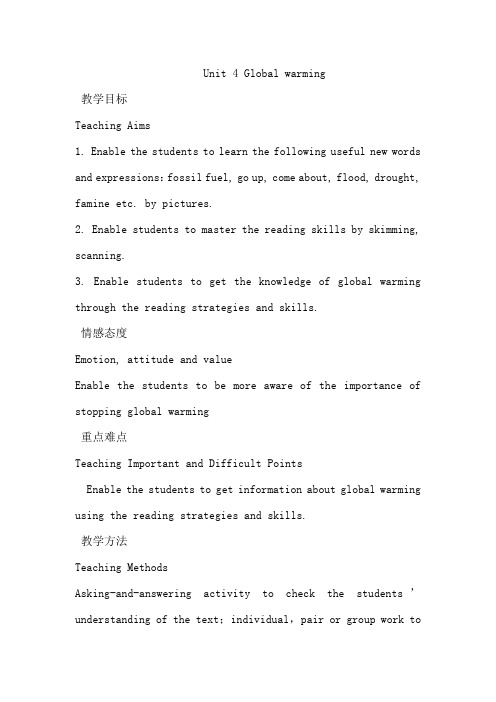
Unit 4 Global warming教学目标Teaching Aims1. Enable the students to learn the following useful new words and expressions:fossil fuel, go up, come about, flood, drought, famine etc. by pictures.2. Enable students to master the reading skills by skimming, scanning.3. Enable students to get the knowledge of global warming through the reading strategies and skills.情感态度Emotion, attitude and valueEnable the students to be more aware of the importance of stopping global warming重点难点Teaching Important and Difficult PointsEnable the students to get information about global warming using the reading strategies and skills.教学方法Teaching MethodsAsking-and-answering activity to check the students’understanding of the text;individual,pair or group work tofinish each task.5教学过程Teaching ProceduresStep 1. Lead-in1) Greetings and lead in.Show a film of The Day After Tomorrow and ask them the following question:What can you see in the film?--hurricane, tsunami, glacier melting .What other disasters do you know?--Flood, drought, famine.What causes the disasters?--It’s the global warming.What causes the the global warming?--Picture1: the burning of fossil fuelsPicture2: greenhouse gases: carbon dioxide, water vapor, methaneAs a result, the earth will become warmer and warmer.Step 2. Skimming:Glance the first paragraph:1. Who wrote the magazine article?A. Janice FosterB. Sophie Armstrong2. What is the topic of the article?A. The earthB. Global warming3. There are the names of the three scientistsin the article EXCEPT______.A. Dr Janice FosterB. Sophie ArmstrongC. Charles KeelingD. George HambleyStep 3. Scanning for detailed information (Group work)Part2(2-5)1. What do the two graphs show?--The first graph shows the temperature increase of one degree Fahrenheit between 1860 to 2000.--The second graph shows carbon dioxide went up from 1957 to 19972. What do you know about greenhouse effect?Greenhouse gases trap(吸收) the heat from the sun and therefore warm the earth.3. Which following is NOT TRUE about global warming? (D)A. The increase of temperature is due of the burning of the fossil fuels.B. The burning of the fossil fuels caused the increase in carbon dioxide.C. All believes that activities of humans have caused globalwarming.D. The attitudes of scientists toward it are the same. The different ideas of the effects of the global warming Part3(6)Step 4. SummaryWhat can we learn from the text? Fill in the bland.A. fossil fuelsB. human activityC.warmerD.differentE. heatEveryone believes that the earth is becoming ______. _______________ has caused this global warming: human produce energy by burning ___________. During this process, Dr. Foster HambleyMore carbon dioxide hasnegative effects: rise of the sea level severe storms, droughts, floods, famines, the spread of diseases,thedisappearance of species. More carbon dioxide is a_positive_ thing,makes crops __produce__more and will encourage __agreat range of animals____.greenhouse gases are produced. Greenhouse gases can trap _____ from the sun and warm the earth which is called “greenhouse effect”.The attitudes of scientists towards global warming are ______. On the one hand, it is a positive thing. On the other hand, if there are too many greenhouse gases, more heat will be trapped, causing global warming.Step 5. After-reading group workWhat should we do to stop global warming?Discussion: Suggestions on global warming:turn off the electrical appliancetalk with family and friends about itrecycle things like bottles, plasticsplant more treesride bike rather than carwords 参考词汇: reduce, carbon dioxide, absorb, environment, plant, electrical appliances, recycleSentences structures 句型:We should ... in order to ...moIt is a good idea to ... because it can ...e.g. We should plant more trees in order to absorb the carbon dioxide .It is a good idea to plant more trees because it can absorb the carbon dioxide .Suggestions about global warmingNowadays, global warming is becoming warmer and warmer. It's time for us to take some actions to deal with it.Firstly, we should ________________________________________ in order to _______________________________________. Secondly, it's a good idea to _______________________________________ because _______________________________________.Finally, why not ______________________ because________________________.Let us save energy and stop the global warming together.Step 6. HomeworkWrite a short passage about the suggestions.精美句子1、善思则能“从无字句处读书”。
人教版高中英语选修6教案:Unit+4+Global+Warmingperiod3.doc
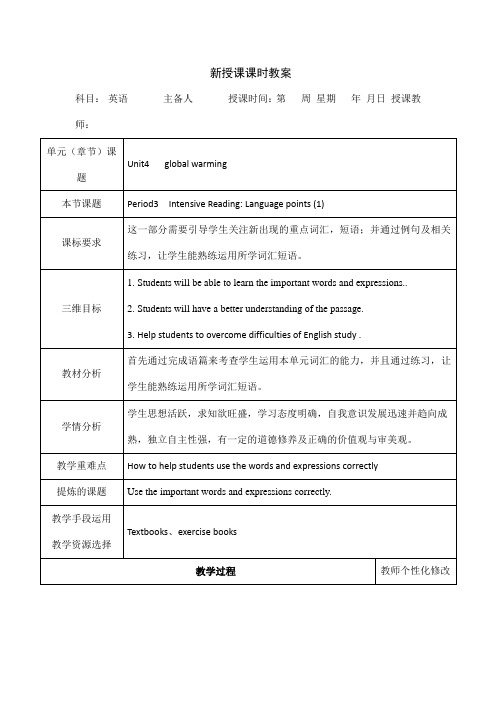
新授课课时教案科目:英语主备人授课时间:第周星期年月日授课教师:品味人生1、不管鸟的翅膀多么完美,如果不凭借空气,鸟就永远飞不到高空。
想象力是翅膀,客观实际是空气,只有两方面紧密结合,才能取得显着成绩。
2、想停下来深情地沉湎一番,怎奈行驶的船却没有铁锚;想回过头去重温旧梦,怎奈身后早已没有了归途。
因为时间的钟摆一刻也不曾停顿过,所以生命便赋予我们将在汹涌的大潮之中不停地颠簸。
3、真正痛苦的人,却在笑脸的背后,流着别人无法知道的眼泪,生活中我们笑得比谁都开心,可是当所有的人潮散去的时候,我们比谁都落寂。
4、温暖是飘飘洒洒的春雨;温暖是写在脸上的笑影;温暖是义无反顾的响应;温暖是一丝不苟的配合。
5、幸福,是一种人生的感悟,一种个人的体验。
也许,幸福是你风尘仆仆走进家门时亲切的笑脸;也许,幸福是你卧病床上百无聊赖时温馨的问候;也许,幸福是你屡遭挫折心灰意冷时劝慰的话语;也许,幸福是你历经艰辛获得成功时赞赏的掌声。
关键的是,你要有一副热爱生活的心肠,要有一个积极奋进的目标,要有一种矢志不渝的追求。
这样,你才能感受到幸福。
6、母爱是迷惘时苦口婆心的规劝;母爱是远行时一声殷切的叮咛;母爱是孤苦无助时慈祥的微笑。
7、淡淡素笺,浓浓墨韵,典雅的文字,浸染尘世情怀;悠悠岁月,袅袅茶香,别致的杯盏,盛满诗样芳华;云淡风轻,捧茗品文,灵动的音符,吟唱温馨暖语;春花秋月,红尘阡陌,放飞的思绪,漫过四季如歌。
读一段美文,品一盏香茗,听一曲琴音,拾一抹心情。
8、尘缘飞花,人去楼空,梦里花落为谁痛?顾眸流盼,几许痴缠。
把自己揉入了轮回里,忆起,在曾相逢的梦里;别离,在泪眼迷朦的花落间;心碎,在指尖的苍白中;淡落,在亘古的残梦中。
在夜莺凄凉的叹息里,让片片细腻的柔情,哽咽失语在暗夜的诗句里。
9、用不朽的“人”字支撑起来的美好风景,既有“虽体解吾犹未变兮”的执着吟哦,也有“我辈岂是蓬蒿人”的跌宕胸怀;既有“我以我血荐轩辕”的崇高追求,也有“敢教日月换新天”的豪放气魄。
人教版高中英语选修6《Unit4Globalwarming》教案

人教版高中英语选修6《Unit 4 Global warming 》教课设计人教版高中英语选修6《 Unit 4 Global warming 》教课设计【一】教课准备教课目的Teaching Aims:In this class Ss will be able to① practice skimming and scanning for information needed like what are the two concerns and what are Earth Cares suggestions.② Master the phrases such as: put up with, so long as, and so on, makea difference, have no effect on , by making sentences or by using theminto the post er.③ bee aware of the serious effects of global warming and the importance of saving energy to be environmentally friendly.④Summarize the points according to their understanding.⑤work together to design a poster by using the suggestions in thearticle.教课重难点Teaching Difficulties:Students may find it hard to add more suggestions about how to save energy in our daily life and to summarize the points according to those suggestions. Students maynot know clear what is a poster and how to design an attractive and persuasive poster in short time.教课过程Teaching Procedure:Step1. Lead-in (inpidual collective work)1.Teacher begins the class by asking: Have you ever seen the movieThe Day After Tomorrow? and then let students enjoy a short movieclip with the following two questions:①What kinds of disasters have you seen in the film?②Can you guess how they came about (happen)?2.introduce the topic:global warming. And then have a further question:①What other disaster will be caused by global warming?【 Designing Purpose 】To arouse students interest by watching the movie clip and educe thetopic, that is global warming. And then by showing a lot of pictures,make students know and understand the terrible effects of global warming, thus making preparations for promoting environmental protection.① who is the writer?② what are his two concerns?Scanning: Read the second letter and answer the following questions:①Does Earth Care agree with Ouy ang Guangs opinion thatinpiduals can have no effect?②what are Earth Cares suggestions?③Can we carry those suggestions out? Why?【Designing Purpose 】To help the students grasp the main information of the two letters by skimming and scanning. While stud ents get the answer to question1,ask them to find the supporting sentence : Together, inpiduals can makea difference. We do not have to put up with pollution. Guess themeanings of the two italicized phrases according to the surroundings andtheir understanding.Step3. Post reading (Pair work)1.Discussion: Make students discuss whether they can find moreways or suggestions about reducing carbon dioxide and saving energy inour daily life.Suggested ways:1)Use less hot water 7)Change a light bulb 8)Try car sharing2)Take a shower instead of a bath3)Buy fresh food instead of frozen4)Buy things that are actually in season5)Eat less high fat food like KFC and Macdonald6)Clean filters(过滤器) on your air conditioner.【Designing Purpose 】To cultivate students to work in pairs and learn to summarize an opinion and share the knowledge of saving energy in daily life. To practice theability of understanding the meaning of new words and expressionsto remove the obstacles in reading.Step4. learn what is a poster (collective work)Know what is a poster by giving a simple sample and try to getthe structure.【Designing Purpose 】To know clearly a poster should have a heading, contents and an eye-catching slogan, which will make it easy for students to design anacceptable poster.Step5. Prepare the poster (inpidual group work)1. Decide our content s:①Choose and decide five most important suggestions. (inpidual work)②W rite them downon your paper and try to makethem persuasive by using imperativesentences. (inpidual work)③pare your list with your group membersand decide five for your poster. (groupwork)2. Slogan and heading: showing sample posters to help them decide aheading and a slogan for your poster.【Designing Purpose 】This is the most important part of this writing task. Students willbe able to summarize and pose sentences by choosing and organizingwhat they want to say, thus improving their writing ability and the processof output based on what they have learned in reading part. And by learning some sample posters to help them decide their own heading and slogan.Step6. produce show time (group work)With the heading, slogan and ways, students will not find it difficultto make a poster. What theyShould pay attention is how to illustrate their poster and makeit more attractive. And then choose several pairs to represent their posters.【Designing Purpose 】Making the poster will improve their cognitive capability of theimportance of environmental protection and at the sametime they can enjoya sense of achievement in show time. And they make believe that inpiduals can really make a difference.课后习题Homework :Put their poster up around the school to make more students know about energy saving and global warming. Write a short passage to tell othershow to solve the problem of global warming based on the suggestionsyou have collected and send it in your zone or blog.板书板书设计: tsunami/ flood/More suggestions: make full use of paper/ use both sides ofpaper reuse waterlimit the time of using private carssend emails instead of cardsuse less hot wateralways take a shopping bag with youdrive a bicycle but not e-bicycle人教版高中英语选修6《Unit 4 Global warming 》教课设计【二】教课准备教课目的Teaching goals教课目的1. Target language目口号言a.要点词汇和短语energy, light (v.), heat (v.), renewable, non-renewable, fuel, blame, run outb.社交用语I dont think so.I dont think thats right.Im afraid you are wrong.2. Ability goals 能力目标Enable the students to talk about different sources of energy andexpress their own ideas.3. Learning ability goals 学能目标Help the students learn how to give their ideas about the use of energy.教课重难点Teaching important points 教课要点Enable the students to express agreement and disagreement.Teaching difficult points 教课难点Enable the students to learn how to express agreement and disagreement.教课过程Step ⅠRevisionT:Good morning, everyone.Ss: Good morning, teacher.T: Sit down, please. Before class, Ill check your homeworkfirst.Mary, would you read your homework to us?Check the students homework and have a discussion with the studentsabout the mistakes Mary made. Let the students have a clear understanding about the mistakes and then correct them.Step ⅡWarming upT: As we all know,we depen d on energy to do many things in our daily life. Some people even say we could do nothing without energy. Can youtell me what we use energy for?Sa: Energy lights our cities.Sb: Energy heats our buildings.Sc: Energy entertains us. With the help of electricity, people havegot a lot of fun from watching TV, playing puters and so on.Sd: There are many other electrical appliances that make our life more convenient and fortable such as washing machines, microwaves,air conditioners and so on.Se: Today energy also helps people realize many so-called dreams inthe past. For example, people can fly from one place to another by planewhich runs on energy.Sf:Its true. In fact, not only planes but also cars, ships and trains run on energy.T:Well done. All that youve just said is right. So it seems that energy plays a very important role in the modern world. Then where does all theenergy e from? Open your books and turn to page 25. Look at thepictures on this page. They may help you find out the answers.After a while.T:Whod like to tell us your answers?Sg: Wind power.Sh: Coal power.T:Right. Is there any difference between them?Si: Yes. Wind will never run out while coal is a limited source.T:Its true. As we know, an energy source is renewable when suppliesof it never run out while some supplies,such as coal, will definitelyrun out one day. Energy of this kind is called non-renewable sources.Please think of as many sources as you can and decide which energy sourceson your list are renewable and which are non-renewable.If necessary, give some words related to the pictures which might bedifficult for the students such as oil refinery,hydroelectric power and so on.The teacher should also collect as much information about differentsources of energy as possible and show it to the students in class through a puter. In this way, the students will bee more interested in this topic and their knowledge on this aspect will be enlarged.T: Fromwhat weve just talked about, it is clear that energy does a lot of good to every coin has two sides. Is there any negative effect of using energy?Sa: use too much energy which is resulting in an increase in carbonis how the global warming es about.Sb: Andmeanwhile it pollutes the environment.T: Itstrue. Many people have realized the problem. Next well do some listeningpractice on this topic. Lets see what other people think of this issue.Thestudents are asked to read the questions quickly to find out the listeningpoints first.Then listen to the tape twice and give the correct answers.T: Nowplease turn to page 31. Lets do listening. Before you listen to the tape,please read fast the statements in Exercise 1 to find out thelistening much attention to the key points while listening.Play thetape for the first time. Help the students get a generalunderstanding aboutthe dialogue. The students listen and try to finishExercise 1. Play the tapeagain, train the students ability to spot specific information and understandthe implication in the dialogue.The students listen and finish Exercise 2.Severalminutes later.T:Have you finished the exercises?Ss: Yes.T: OK,lets check your answers.Explainsome difficult points if necessary.T: Nowread what Professor Chen and Li Bin say. Work in groups. Discuss who you agreewith and give reasons. Use some of the phrases listed in Exercise 2 or anyothers you know.课后习题Homework1.Review the new words and expressions you learned in this class.2.Preview Reading.。
Unit4 Global Warming教案电子教案

U n i t4G l o b a l W a r m i n g教案Unit4 Global WarmingTeaching aims: To make students realize the harm of global warming and how to protect the earth from global warming ;To develop students’ sense of cooperative ability;Teaching important points : To enable students to learn about global warming and to develop their reading ability.Teaching difficult points: To enable students to talk about what we should do toprevent global warming.Teaching aids: MultimediaTeaching procedures:Step1 Warming upTalk about weather and lead the relationship between severe cold weather and global warming.Then play a video and ask students to think about what the video shows so as to lead today’stopic-global warming.Step2 TalkingPlay a second video and the students are supposed to talk about what is happening in the video. Then the teacher comes to a conclusion:The animals’ habitats are destroyed. That means animals will die out one day.Step3 pre-readingAsk students questions:What is a greenhouse made of and used for?Have you ever seen a green house?A greenhouse is made of ______ and is used for ______________,especially during_____weather.Step4 group workAsk students to work in groups to discuss how does a greenhouse work?The answer:The glass traps the heat from the sun and keeps it from escaping. So the air inside is warm. This makes the greenhouse heat up and so the plants can grow throughout the cold period.Step5 reading•Ask students to skim the passage quickly and answer the following questions: What are the “greenhouse gases”?•Who talked about “greenhouse effect”?•What is greenhouse effect?•And then check the answers. And then ask them to read it again and work in pairs to answer :Can we live without greenhouse effect?•Who wrote the article?•What’s the name of the magazine?•What are the names of the three scientists mentioned in the article?•What did Charles Keeling find? And do you agree with her?•Does George Hambley agree with Dr Janice Foster?•What does Hambley say about carbon dioxide?Step5 detailed readingThe teacher tells that the test can be divided into 4 parts so show them a diagram and ask them to match which part with the right main idea.Step6 An activity—Make a posterSaving energy means reducing carbon dioxide, which is our duty.What should we do to slow down global warming?Make a poster for our school that tells students various ways they can reduce the amount of carbon dioxide in the air.Step7 Homework•Composition:•以“how to slow down global warming?”为题写一篇发言稿。
高中英语Unit4GlobalWarming学案3新人教版选修6
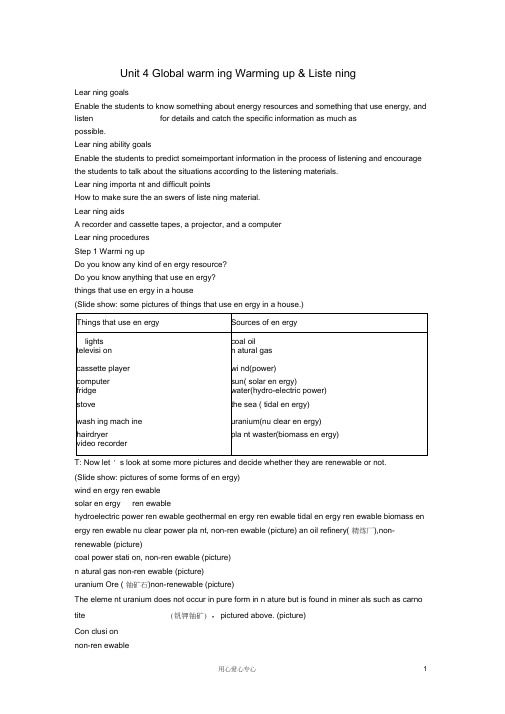
Unit 4 Global warm ing Warming up & Liste ningLear ning goalsEnable the students to know something about energy resources and something that use energy, and listen for details and catch the specific information as much aspossible.Lear ning ability goalsEnable the students to predict someimportant information in the process of listening and encourage the students to talk about the situations according to the listening materials.Lear ning importa nt and difficult pointsHow to make sure the an swers of liste ning material.Lear ning aidsA recorder and cassette tapes, a projector, and a computerLear ning proceduresStep 1 Warmi ng upDo you know any kind of en ergy resource?Do you know anything that use en ergy?things that use en ergy in a house(Slide show: some pictures of things that use en ergy in a house.)T: Now let ' s look at some more pictures and decide whether they are renewable or not.(Slide show: pictures of some forms of en ergy)wind en ergy ren ewablesolar en ergy ren ewablehydroelectric power ren ewable geothermal en ergy ren ewable tidal en ergy ren ewable biomass en ergy ren ewable nu clear power pla nt, non-ren ewable (picture) an oil refinery( 精炼厂),non-renewable (picture)coal power stati on, non-ren ewable (picture)n atural gas non-ren ewable (picture)uranium Ore ( 铀矿石)non-renewable (picture)The eleme nt uranium does not occur in pure form in n ature but is found in miner als such as carno tite (钒钾铀矿) ,pictured above. (picture)Con clusi onnon-ren ewablecoal oil n atural gas Uranium fossil fuelsren ewablewi nd (wi nd power) sun (solar en ergy) water (hydro-electric power)pla nt waste (biomass en ergy) hot spri ngs or geysers (geothermal en ergy) the sea (tidal en ergy) Slide showWhat are fossil fuels?Ancient animal and plant material below the surface of the earth with a high ca rbon content, such as coal, oil and n atural gas, which can be burnt to produce en ergy.Also known as non-ren ewable en ergy because once they are used they have gone forever; they cannot be ren ewed.Step 2 Pre-liste ningRead Exercise 1 together:1. Read the stateme nts below and tick the ones you agree with.2. Liste n to the tape and an swer and decide which stateme nt Professor Chen does NOT agree with.1. We'll have to stop using fossil fuels.2. About 90% of the world's en ergy comes from fossil fuels.3. We can replace fossil fuels with ren ewable sources of en ergy.4. Nuclear power is a good source of en ergy.5. I n the future, we'll n eed new tech no logies to replace fossil fuels.6. It's the developed coun tries who are to blame for produci ng most of the carb ondioxide.3. Liste n aga in and tick the phrases that Professor Chen uses to agree or disag ree with Li Bin. Slide showExactly. ___ I ' m afraid I disagree with you. ____________That's true. I ' m afraid not.That's right. I don ' t think so.That's correct. No way.I agree I don ' t agree.4. Listen for the third time and fill in the blanks.1. ____________________ Our moder n _______________________________ societies depe nd on the en ergy we get from _______________________________________2. ________________________ It ' s a very a nd cheap form of energy.3.Can' t we just ________ fossil fuels with _______ sources of energy like sun or wind power?4.However, whatever we do, we have to do it as a ______________ .5.The ________ countries are really the ones to _____ .Keys:1. in dustrial; fossil fuels2. concen trated 3 。
英语:Unit4 Global warming Period 3优秀教案(新人教版选修6)
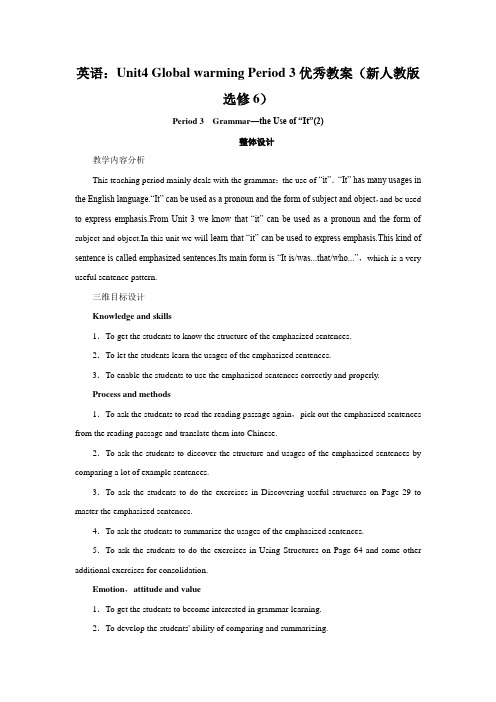
英语:Unit4 Global warming Period 3优秀教案(新人教版选修6)Period 3Grammar—the Use of “It”(2)整体设计教学内容分析This teaching period mainly deals with the grammar:the use of “it”.“It” has many usages in the English language.“It” can be used as a pronoun and the form of subject and object,and be used to express emphasis.From Unit 3 we know that “it” can be used as a pronoun and the form of subject and object.In this unit we wil l learn that “it” can be used to express emphasis.This kind of sentence is called emphasized sentences.Its main form is “It is/was...that/who...”,which is a very useful sentence pattern.三维目标设计Knowledge and skills1.To get the students to know the structure of the emphasized sentences.2.To let the students learn the usages of the emphasized sentences.3.To enable the students to use the emphasized sentences correctly and properly.Process and methods1.To ask the students to read the reading passage again,pick out the emphasized sentences from the reading passage and translate them into Chinese.2.To ask the students to discover the structure and usages of the emphasized sentences by comparing a lot of example sentences.3.To ask the students to do the exercises in Discovering useful structures on Page 29 to master the emphasized sentences.4.To ask the students to summarize the usages of the emphasized sentences.5.To ask the students to do the exercises in Using Structures on Page 64 and some other additional exercises for consolidation.Emotion,attitude and value1.To get the students to become interested in grammar learning.2.To develop the students' ability of comparing and summarizing.教学重、难点1.To get the students to master the structure and usages of the emphasized sentences.2.To enable the students to learn how to use the emphasized sentences.教学过程Step 1Revision1.Check the homework exercises.2.Dictate some new words and expressions.Step 2Warming upAsk the students to compare the two sentences below.The second sentence is from the reading passage.Translate them into Chinese and then discuss any difference in meaning and form.Ask the students to explain why “it” is used in the second sentence.Human activity has caused this global warming.It_is human activity_that has caused this global warming.Tell the students there are two more sentences in the text in which “it” is used for emphasis.Find them and then write them down.________________________________________________________________________ ________________________________________________________________________ Suggested answers:1.It_was a scientist called Charles Keeling,who made accurate measurements of the amount of carbon dioxide in the atmosphere from 1957 to 1997.2....it_is the burning of more and more fossil fuels that has resulted in this increase in carbon dioxide.Step 3Grammar learningAsk the students to study the following sentences and try to summarize the structure of the emphasized sentences.Tom found my pen in the classroom yesterday.It was Tom who/that found my pen in the classroom yesterday.It was my pen that Tom found in the classroom yesterday.It was in the classroom that Tom found my pen yesterday.It was yesterday that Tom found my pen in the classroom.Step 4Summing upTry to help the students draw the following conclusions.1.The main structure of the emphasized sentences is “It is/was...that/who...”.2.The emphasized sentences can be used to emphasize the subject,object and adverbial(including adverbial of time and adverbial of place).3.When we want to emphasize the subject,object and adverbial,we only need to put these parts between “it is/was” and “that/who”,the rest part shouldn't be changed.4.When the emphasized part is a person we can use both the structure “It is/was...that...” and the structure “It is/was...who...”.When the emphasized part is not a person we can only use the structure “It is/was...that...”.Step 5Grammar practiceAsk students to do the following exercises:1.Change the following sentences into emphasized sentences.(To emphasize the underlined parts.)(1)Peter lent us the money.(2)They want money.(3)All this happened on_Monday.(4)I didn't hear from her until_last_summer.(5)Why does everyone think I am narrow-minded?Suggested answers:(1)It was Peter who lent us the money.(2)It is money that they want.(3)It was on Monday that all this happened.(4)It was not until last summer that I heard from her.(5)Why is it that everyone thinks I am narrow-minded?The last two may be a little difficult for the students.Help them to get the correct answer.2.Do Exercise 2 in Discovering useful structures on Page 29.3.Do the exercises in Using Structures on Page 64.First ask students to do the exercises individually,and then let them discuss and check their answers with their partners,and finally give them correct answers and deal with any problems they might meet.Step 6Getting more about the grammarShow the following sentences to the students and ask them to find what the similarity of these sentences is.(1)It is what you do rather than what you say that matters.(2)It was after he got what he had desired that he realized it was not so important.(3)It was not until she got home that Jennifer realized she had lost her keys.Suggested answers:In these three sentences,the underlined parts are all clauses—a subject clause and two adverbial clauses.That is to say,the emphasized sentence can not only be used to emphasize subject,object and adverbial,but also be used to emphasize subject clauses and adverbial clauses.Pay special attention to the third sentence,in which “not” and “until” must be put together.Then show the following two sentences to students and ask them to translate them into Chinese.Pay attention to the sentence pattern.(1)Was it in 1969 that the American astronauts succeeded in landing on the moon?(2)Who was it that put so many large stones on the road?Suggested answers:(1)美国宇航员是于1969年成功登陆月球的吗?(2)究竟是谁在路上放了这么多大石头?The general question sentences and the wh-question sentences of the emphasized sentences should follow the following formulas:Is/Was it+被强调部分+that+其他部分Wh-疑问词+is/was it that+其他部分Step 7Task-based learningAsk students to choose a topic they like(eg.global warming,wildlife,protection,music,film,etc).Work in groups and try to tell the information they know about the topic using emphatic “it”.EXAMPLES:It was during the 20th century that the temperature of the earth went up about one degree Fahrenheit.It was Charles Keeling who made accurate measurements of the amount of carbon dioxide in the atmosphere.Step 8Closing down by a quizShow students the following on the screen or give out test papers to them and then ask them to finish these exercises in 10 minutes.1.Was it in this place ______ they once built a tall building?A.that B.in whichC.before D.which2.It is ______ he often breaks the school rules ______ makes his head teacher unsatisfied with him.A.what;that B.that;whatC.that;that D.because;that3.It is because English is being widely used at present ______.A.why we learn it hard B.that we learn it hardC.which we must learn D.when we should learn4.—Was it what he said or something that he did ______ made you cry so sadly,Sarah?—No,not really.A.which B.thatC.when D.what5.______ the people have become masters of their country ______ science can really serve the people.A.It is only then;that B.It was that;whenC.It is only when;that D.It was when;then6.—I think we have met the word before.—Yes.It is in the reading material ______ we ______ reading yesterday.A.that;did B.that;wereC.when;were D.when;did7.It was there,the police believe,______ she was able to activate the recorder she kept in her bag.A.until B.whichC.that D.when8.It was this sense of failure ______ made him determined to succeed in his new life.A.who B.whichC.that D.why9.______ that so many people think that being perfect is the way to go?A.It is why B.Why is itC.Why it is D.Is why it10.When asked to explain ______ he does to make his students so enthusiastic about school,he pauses and thinks deeply.A.what it is that B.that what it isC.what is it that D.that what is it11.—Wasn't it Dr Wang who spoke to you just now?—______.A.I didn't know who was B.Yes,it wasC.No,he wasn't D.Yes,he did12.It was ______ he said at the meeting last night ______ made me angry.A.what;that B.that;thatC.what;what D.that;what13.Was ______ that I saw last night at the concert?A.it you B.not youC.you D.that yourself14.It was the nervousness in the interview ______ probably lost him the job.A.which B.sinceC.that D.what15.It was ______I reached there ______ I began to know something about the matter.A.until;when B.until;thatC.not until;that D.not when;that16.It was ______ my father worked ______ I worked now.A.where;that B.where;whenC.that;where D.that;that17.What a silly mistake it is ______ you've make!A.it B.thatC.this D.whichSuggested answers:1~5 ACBBC6~10 BCCBA11~15 BAACC16~17 ABStep 9Homework1.Finish off the Workbook exercises.2.Preview the new words and expressions left in Unit 5 and the passage on Page 30.Mark any part they can't understand well.Step 10Reflection after teaching________________________________________________________________________ ________________________________________________________________________。
人教版选修六Unit 4 Global warming教案
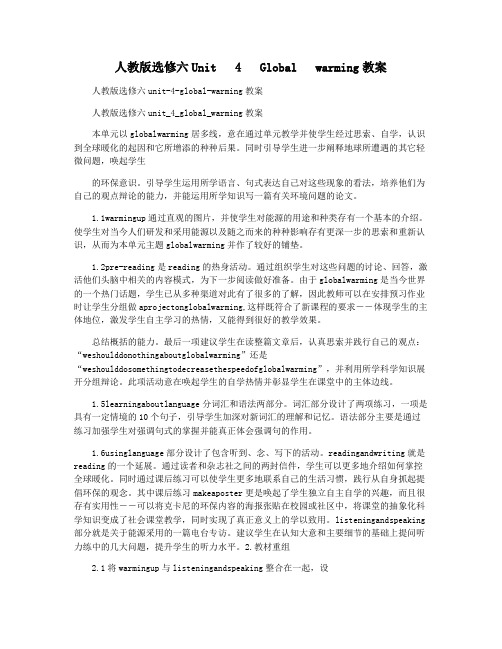
人教版选修六Unit 4 Global warming教案人教版选修六unit-4-global-warming教案人教版选修六unit_4_global_warming教案本单元以globalwarming居多线,意在通过单元教学并使学生经过思索、自学,认识到全球暖化的起因和它所增添的种种后果。
同时引导学生进一步阐释地球所遭遇的其它轻微问题,唤起学生的环保意识。
引导学生运用所学语言、句式表达自己对这些现象的看法,培养他们为自己的观点辩论的能力,并能运用所学知识写一篇有关环境问题的论文。
1.1warmingup通过直观的图片,并使学生对能源的用途和种类存有一个基本的介绍。
使学生对当今人们研发和采用能源以及随之而来的种种影响存有更深一步的思索和重新认识,从而为本单元主题globalwarming并作了较好的铺垫。
1.2pre-reading是reading的热身活动。
通过组织学生对这些问题的讨论、回答,激活他们头脑中相关的内容模式,为下一步阅读做好准备。
由于globalwarming是当今世界的一个热门话题,学生已从多种渠道对此有了很多的了解,因此教师可以在安排预习作业时让学生分组做aprojectonglobalwarming,这样既符合了新课程的要求――体现学生的主体地位,激发学生自主学习的热情,又能得到很好的教学效果。
总结概括的能力。
最后一项建议学生在读整篇文章后,认真思索并践行自己的观点:“weshoulddonothingaboutglobalwarming”还是“weshoulddosomethingtodecreasethespeedofglobalwarming”,并利用所学科学知识展开分组辩论。
此项活动意在唤起学生的自学热情并彰显学生在课堂中的主体边线。
1.5learningaboutlanguage分词汇和语法两部分。
词汇部分设计了两项练习,一项是具有一定情境的10个句子,引导学生加深对新词汇的理解和记忆。
- 1、下载文档前请自行甄别文档内容的完整性,平台不提供额外的编辑、内容补充、找答案等附加服务。
- 2、"仅部分预览"的文档,不可在线预览部分如存在完整性等问题,可反馈申请退款(可完整预览的文档不适用该条件!)。
- 3、如文档侵犯您的权益,请联系客服反馈,我们会尽快为您处理(人工客服工作时间:9:00-18:30)。
英语:Unit4《Global warming》教案(3)(新人教版选修6)Pre-reading, Reading, ComprehendingTeaching Goals:1.To read about global warming.2.To get some idea about the effect of global warming.3.To develop some basic reading skills.Teaching Procedures:Step 1. Warming UpPurpose: To arouse Ss interest in learning about global warming.1. Team workAnswer the questions below:(1) Have you ever seen a greenhouse?(2) How does a greenhouse work?(3) What do you think greenhouse gases do?2. Group workLook at the picture, and ask Ss some questions.T: What is this building made of?S1: It’s made of plastic.T: What’s its purpose?S2: Plants can grow in it when it’s cold outside.T: How does it work?S3: The glass traps the heat from the sun, making the air warm so that plants grow better.Step 2. Pre-readingPurpose: To get Ss to learn about greenhouse gases.1. Group workNow look at the word “GREENHOUSE GASES”. What does it mean?Greenhouse gases (GHG) are gaseous components of theatmosphere that contribute to the greenhouse effect .The majornatural greenhouse gases are water vapor, which causes about 36-70% of the greenhouse effect on Earth (not including clouds): carbon dioxide, which causes between 9-26%; and ozone, which causes between 3-7%(note that it is not really possible to assert that such-and-such a gas causes a certain percentage of the GHE, because the influences of the various gases are not additive .The higher ends of the ranges quoted are for the gas alone ;the lower end ,for the gas counting overlaps).Naturally occurring greenhouse gases include water vapor, carbon dioxide, methane, nitrous oxide, and ozone. Certain human activities, however, add to the levels of most of these naturally occurring gases.Very powerful greenhouse gases that are not naturally occurring include hydrofluorocarbons (HFCs), perfluorocarbons (PFCs), and sulfur hexafluoride (SF6), which are generated in a variety of industrial processes.Each greenhouse gas differs in its ability to absorb heat in the atmosphere. HFCs and PFCsare the most heat-absorbent.2. Individual workGet Ss to answer these questions individually. Then let them discuss the answers.(1) Who wrote the magazine article? What is the name of the magazine?(2) What are the names of the three scientists mentioned in the article?(3) What do they think about global warming? Do they agree with one another?(4) What are the two graphs about?(5) What is the main topic of the article?Step 3. Reading1. SkimmingPurpose: To get a brief understanding of the text.Read through the text, preferably the first and the last sentences of each paragraph and write the key sentence of each paragraph.Key sentences of each paragraph:(1) A debate over whether it is human activity that has caused the global warming or whether it is just a natural phenomenon.(2) Many scientists believe people have caused the increase in the earth’s temperature.(3) The increased extra amount of carbon dioxide traps more heat energy causing the global temperature to go up.(4) The levels of carbon dioxide have increased greatly over the last 100 to 150 years.(5) There are some different attitudes towards the causes of this increase in carbon dioxide.(6) Over the next 100 years the amount of warming could be as low as 1 to 1.5 degrees Celsius but it could be as much as 5 degrees Celsius.(7) An increase of five degrees would be a catastrophe.(8) Future warming would cause the sea level to rise by several meters.(9) Some predict any warming will be mild with few bad environmental consequences.(10) More carbon dioxide is a positive thing.(11) No one knows what the effects of global warming will be.2. ScanningPurpose: To get Ss to have some details in the text.Read the article carefully. Are these statements true or false? Write a T for each true sentence and an F for each false sentence.(1) The temperature last century didn’t increase much. ( )(2) Everyone believes that global warming is caused by the activities of humans. ( )(3) Janice Foster believes that burning fossil fuels causes global warming. ( )(4) Natural gas is a greenhouse gas. ( )(5) Carbon dioxide is a byproduct of burning fossil fuels. ( )(6) People accept Charles Keeling ’s data because he took accurate measurement s. ( )(7) Flooding could be one of the effects of future global warming. ( )(8) George Hambley believes scientists are just guessing about the effects of global warming.( )(9) Geroge Hambley is worried about the effects of carbon dioxide on plant growth. ( )(10) It is clear what the effects of global warming will be.Suggested Answers:(1) F (2) F (3) T (4) F (5) T (6) T (7) T (8) T (9) F (10) F3. ListeningPurpose: To train Ss listening ability.Listen to the tape and follow it in a low voice.4. Group workSs are divided into four groups. Each group is supposed to read through each part and then discuss them.Part 1 (Paragraph 1)compare 比较● 常见用法:①compare…with… 把…和…比较Compared with him, I am fast.②compare…to… 把…比作…Life is often compared to voyage.(2) come about发生How did it come about? 那事是怎么发生的?● 常见词组:come across 偶遇;碰到come round 恢复知觉,come along 进展;进行come to 涉及;到达;共计come out 公开;问世;出版come to oneself 恢复知觉come up with 想出(4) phenomenon n 现象It is only a social phenomenon, but not a phenomenon of nature.Part 2 (Paragraph 2, 3, 4)fuel n 燃料Don’t leave the engine switched on .It wastes fuel.● 拓展:fuel v 加油;补给燃料The car is being fuelled ready to try to beat the speed record.(2) quantities of大量Large quantities of money have been spent on the bridge.● 拓展:a large quantity of大量的He ate a large quantity of nice.(3) per prep 每; 每一The fruit costs 30 pence per kilo.How much do you earn per week?Part 3 (Paragraph 5,6,7,8,9)(1) data n 资料; 数据We haven’t got enough data..(2) result in导致The accident resulted in the death of two passengers.It resulted in success.● 拓展:result from 由于His illness resulted from eating bad food.(3) catastrophe n 突如其来的大灾难;大灾祸The war was a terrible catastrophe in which many people died.(4) climate n 气候We have a mild climate here.(5) consequence n 结果;后果;影响As a consequence of being in hospital, Shelly decided that she wanted to become a nurse.● 常见词组:in consequence 因此,由此in consequence of…由于…的缘故(6) state vt 陈述;说明The busmen have stated that the strike will continue until general agreement is reached about pay and working conditions.(7) range n & v①种类;范围;幅度There is a wide range of temperature.气温变化很大。
